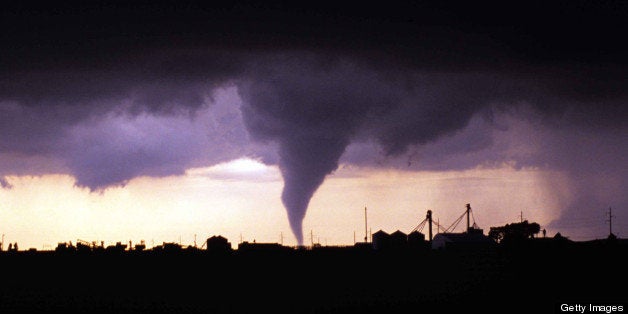
Climate change chatter ran rampant after an unusually violent string of twisters in 2011, including a Joplin, Mo., storm that killed 158 people. After tornadoes took at least 24 lives in Moore, Okla., on Monday, headlines -- like this one -- are once again raising the question: Will a warming world fuel more tornado strikes?
"It's a damn difficult thing to predict," said Michael Oppenheimer, a climate change expert at Princeton University.
The factors that contribute to tornado formation are complicated. Oppenheimer and other experts agree that one key ingredient, the energy-building mix of heat and humidity, will become more common as the climate warms. But ample debate remains around how climate change may affect other elements, in particular the prerequisite twisting of the wind.
Harold Brooks, a scientist with the National Oceanic and Atmospheric Administration's National Severe Storms Laboratory, suggested that lateral wind shear, which organizes storms, could actually become less favorable for tornadoes as a result of global warming. Meanwhile, Oppenheimer and Michael Mann, a climatologist who directs the Earth System Science Center at Pennsylvania State University, agreed that it's too early to tell.
"If one factor is likely to be favorable and the other is a wild card, it's still more likely that the product of the two factors will be favorable," said Mann. "Thus, if you're a betting person -- or the insurance or reinsurance industry, for that matter -- you'd probably go with a prediction of greater frequency and intensity of tornadoes as a result of human-caused climate change."
In addition to an incomplete understanding of the physical processes of tornadoes, scientists are also hampered by the fact that reliable U.S. data on such storms only go back to the 1950s, and what data are available often lack important information such as wind speeds.
Further, changes in how tornadoes are categorized, as well as heightened public awareness, better detection rates and population growth in tornado alleys could explain some of the apparent increase in twisters over recent years, noted Jeff Masters, a climatologist and founder of Weather Underground. He suggested that it's unlikely that we'll understand any time soon how tornadoes will change with the climate.
Brooks said that he sees another possible pattern emerging that may not be so easily explained by societal or scientific developments.
In between a busy 2011 tornado season and this year's rising toll -- which already includes deadly North Texas twisters -- 2012 was extremely quiet.
"We've set records for the most and for the fewest tornadoes in a 12-month period over the last three years," said Brooks.
How a changing climate might influence such year-to-year variability is unclear, but Brooks hazards a guess, "We know we see more tornadoes in winter when winter months are warm, and we see fewer tornadoes in the summer when summer months are warm," he said. "Last summer, we didn't see very many tornadoes because it was too hot."
"Still, that doesn't explain everything," added Brooks.
Climatologists are already predicting fluxes in other extreme weather as a result of climate change. Oppenheimer offered hurricanes as one example. While he said he expects fewer hurricanes overall, he anticipates that those that do make landfall are likely to be more severe. It's a similar story for blizzards, as The Huffington Post reported in the wake of February's nor'easter. Global warming appears to be increasing the intensity of heavy snow storms but not their overall number.
Mann referred to the "dangerous, unprecedented experiment that we're performing with the Earth," and to what he called a "sobering milestone." Earlier this month, levels of carbon dioxide in the Earth's atmosphere surpassed 400 parts per million -- something the planet hasn't seen in at least 4 million years.
"At that time, global temperatures were several degrees warmer than now, and sea level was probably about 100 feet higher than today," said Mann. "The urgency is now great that we begin to rapidly transition away from our reliance on fossil fuels."
Gwen Ingram, an artist and yoga instructor, is one of many Oklahomans who have protested Keystone XL in recent weeks. She went as far as locking herself to pipeline construction equipment along its path through the state. The proposed project has become a poster child in the climate change debate, and Ingram said she does see a potential connection between climate change and the latest string of tornadoes to rip through her state, which boasts a long history of fossil fuel production and transport.
"They seem to be bigger and more intense," said Ingram of the local tornadoes. "May is the season that we most frequently have them, but these mile-wide tornadoes are not what I remember as a child."

